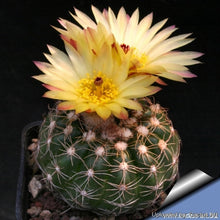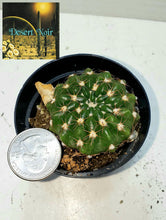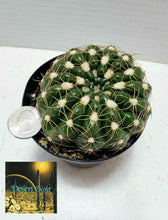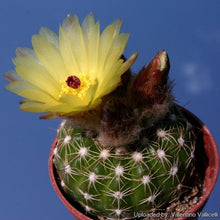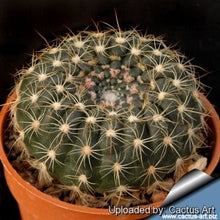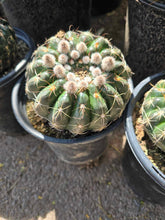
Description: Parodia concinna var. yerbalitoensis (also spelled yerbalitensis or gerbalitoensis) is a local form of the wide ranging and very variable Parodia concinna. The differences with other Parodia concinna are in reality very minimal and most botanist agree on the fact that both should all be included in the Parodia concinna, and the two plants are not readily distinguishable, if not for the geographical provenance.
Habit: It is small cactus species forming a flattened and much-ribbed sphere.
Stem: Simple, broadly globular or somewhat depressed at apex, eventually longer in age, about 3-10 cm tall, and 4-10 cm across, light or dark glossy green, ribbed and warty at the top.
Ribs: about 16 to 20, with somewhat conspicuous chin-like tubercles between the areoles
Areoles: Young areoles white-felted.
Spines: 10 to 12, spreading, setaceous, hair-like to bristle-like, some more or less curved to twisted, brown, reddish or partly whitish to yellowish often poorly differentiated as centrals and radials.
Radial spines: 9 to 25, about 5 to 7 mm long adpressed and interlaced.
Central spines: 1-4(-6), one much longer (1-2,5cm ), spreading or turned downward.
Flowers: 1-5 produced together at the apex, bright yellow, funnel-shaped, large, about 5 to 8 cm across. Outer perianth-segments narrow, acute, reddish, inner perianth-segments oblong, yellow almost transparent, except the reddish tips, acute. Stigma-lobes scarlet. Scales on the ovary hairy in their axils. Perianth-tube slender.
Blooming season: Summer.
Fruit: Green ovoid to globular approx. 1,5 cm cm long, thin-walled, splitting or disintegrating at maturity with more than 100 seeds per fruit.
Seed: 0,8-1 mm, bell-shaped broadest at the hilum, somewhat, tuberculate, shiny and black.
~Bare Root live plant






